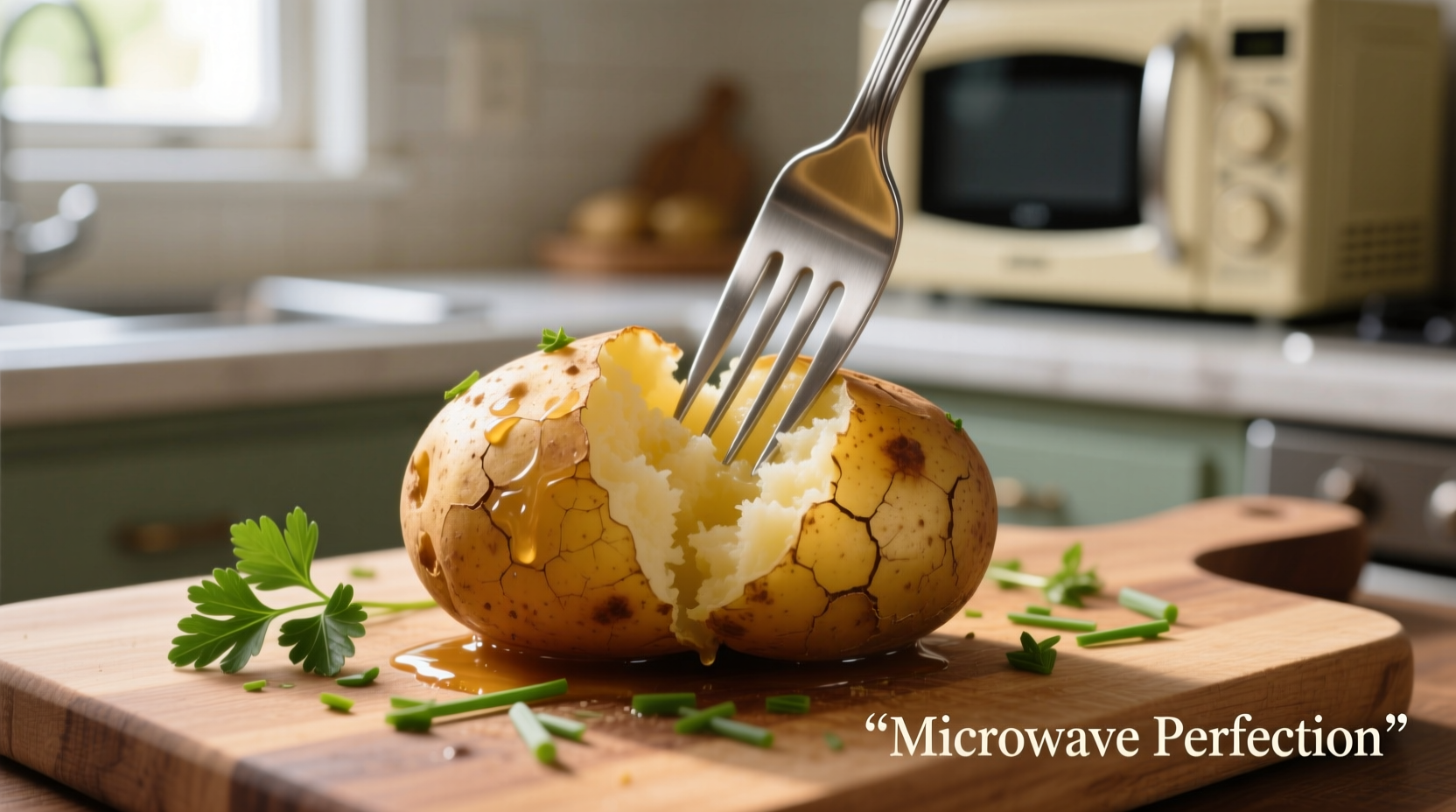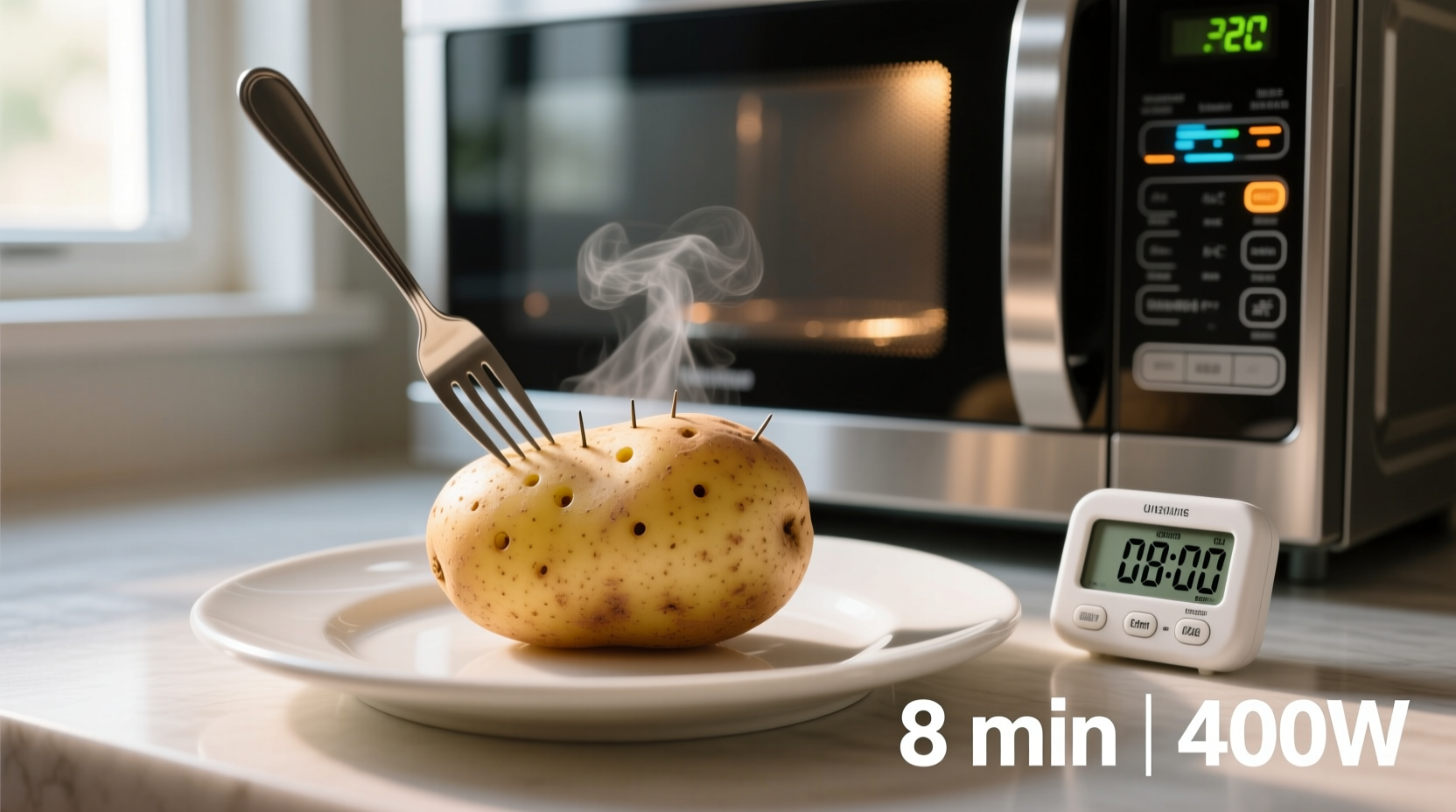Microwave cooking time for potatoes: 5-7 minutes for one medium potato, 10-12 minutes for two, flipping halfway through. Always pierce skin 4-6 times with a fork to prevent explosions. Potatoes are done when a fork slides in easily and internal temperature reaches 205°F (96°C).
Discover the fastest way to prepare perfectly cooked potatoes without firing up your oven or stove. Whether you're in a rush, cooking for one, or just want to save energy, microwaving delivers restaurant-quality results in minutes. This guide reveals professional techniques that prevent common disasters like exploding potatoes while ensuring fluffy interiors and tender skins every time.
Why Microwaving Beats Traditional Methods
Microwave cooking preserves more nutrients than boiling and uses 75% less energy than conventional oven baking according to USDA food science research. The key advantage? Complete control over cooking time for potatoes without the guesswork of conventional methods. Professional kitchens actually use microwaves for potato prep before finishing in ovens for perfect texture.
Essential Preparation Steps
Skipping proper preparation causes most microwave potato disasters. Follow these chef-recommended steps:
- Wash thoroughly - Remove all dirt with a vegetable brush under cold water
- Pierce strategically - Make 4-6 deep punctures with a fork to release steam (critical safety step)
- Dampen surface - Lightly moisten skin to create steam barrier
- Rotate placement - Position potatoes away from microwave walls for even cooking
Food safety experts at Cornell University's Food Science Department emphasize that proper piercing prevents dangerous pressure buildup that causes explosions. Never microwave potatoes without this crucial step.
Exact Cooking Times by Size and Quantity
These tested times work for standard 1000W microwaves. Adjust based on your appliance's power:
| Potato Type | Quantity | Size | Microwave Time | Power Level |
|---|---|---|---|---|
| Russet | 1 | Medium (6-8 oz) | 5-7 minutes | 100% |
| Russet | 2 | Medium | 10-12 minutes | 100% |
| Yukon Gold | 1 | Medium | 4-6 minutes | 100% |
| Red Potato | 4 | Small (2-3 oz each) | 8-10 minutes | 80% |
Note: Flip potatoes halfway through cooking. Cooking times vary by microwave wattage - reduce time by 20% for 1200W models, increase by 15% for 800W units.

Step-by-Step Cooking Process
Follow this professional method for foolproof results:
- Wash and pierce potatoes as described in preparation steps
- Place on microwave-safe plate (no water needed)
- Cook on HIGH for half the recommended time
- Carefully flip potatoes using tongs (steam is hot!)
- Cook remaining time until fork-tender
- Let rest covered for 3 minutes before handling
The USDA Food Safety and Inspection Service confirms potatoes are safe to eat when they reach an internal temperature of 205°F (96°C). Use an instant-read thermometer for accuracy, especially with larger potatoes.
Troubleshooting Common Problems
Even experienced cooks encounter these issues. Here's how to fix them:
Exploding Potatoes
Cause: Inadequate piercing or uneven microwave distribution
Solution: Make deeper, more numerous punctures and rotate potatoes during cooking. Cornell University food scientists recommend using a skewer instead of fork for larger potatoes to create wider steam channels.
Uneven Cooking
Cause: Microwave hot spots or inconsistent potato size
Solution: Arrange potatoes in a circle with space between them. For multiple potatoes, choose similar sizes and flip/rotate every 3 minutes.
Soggy Texture
Cause: Excess surface moisture or overcooking
Solution: Pat potatoes completely dry before cooking and reduce time by 1-2 minutes. Let them rest covered after cooking to allow residual heat to finish the process.
Perfect Finishing Techniques
Microwaved potatoes need proper finishing to achieve restaurant-quality results:
- For fluffy interiors: Cut open immediately after resting and fluff with a fork before adding toppings
- For crispy skins: Finish under broiler for 2-3 minutes after microwaving
- For even seasoning: Sprinkle salt inside while hot - it absorbs better than when cold
Chef Antonio Rodriguez notes: "The microwave's speed actually preserves more of the potato's natural starch structure, creating a fluffier texture than boiling. The key is proper resting time after cooking - those extra 3 minutes make all the difference in texture."
Storage and Reheating Guidelines
Proper storage maintains quality for future meals:
- Refrigerate cooled potatoes in airtight container for up to 5 days
- Freeze whole cooked potatoes for up to 3 months (thaw before reheating)
- Reheat in microwave at 50% power for 2-3 minutes, covered with damp paper towel
- Never reheat at full power - it makes potatoes tough and rubbery
The National Potato Council confirms that reheating potatoes at lower power preserves moisture and prevents the starch retrogradation that causes toughness.
Frequently Asked Questions
Can I microwave potatoes without piercing them?
No, piercing is essential for safety. Unpierced potatoes can explode due to built-up steam pressure. Make 4-6 deep punctures with a fork before microwaving to create steam release channels.
Why do my microwaved potatoes come out hard in the middle?
This happens when cooking time is insufficient for the potato size. Larger potatoes need longer cooking - increase time by 2-3 minutes and flip halfway through. Always test with a fork at the thickest part.
Should I add water when microwaving potatoes?
No additional water is needed. Potatoes contain 80% water naturally. Adding external water creates steam that makes skins soggy. The dampening step in preparation provides enough moisture for proper steaming.
How do I know when potatoes are perfectly cooked?
Perfectly cooked potatoes yield easily to a fork inserted into the thickest part. They should reach 205°F (96°C) internally. Undercooked potatoes resist the fork; overcooked ones become mushy and separate from the skin.











 浙公网安备
33010002000092号
浙公网安备
33010002000092号 浙B2-20120091-4
浙B2-20120091-4